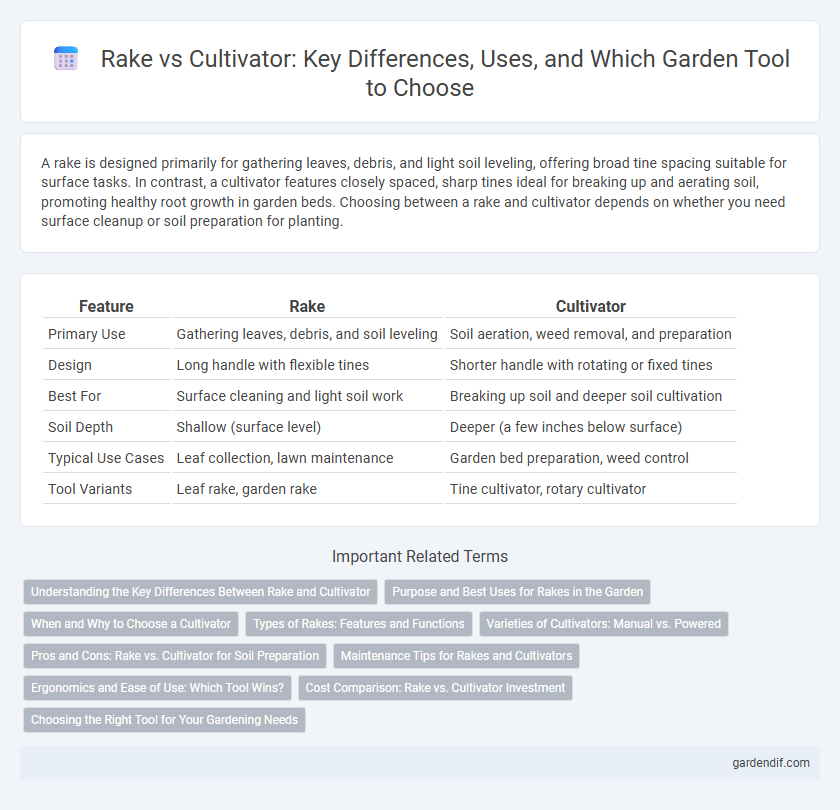
Rake vs Cultivator Illustration
A rake is designed primarily for gathering leaves, debris, and light soil leveling, offering broad tine spacing suitable for surface tasks. In contrast, a cultivator features closely spaced, sharp tines ideal for breaking up and aerating soil, promoting healthy root growth in garden beds. Choosing between a rake and cultivator depends on whether you need surface cleanup or soil preparation for planting.
Table of Comparison
| Feature | Rake | Cultivator |
|---|---|---|
| Primary Use | Gathering leaves, debris, and soil leveling | Soil aeration, weed removal, and preparation |
| Design | Long handle with flexible tines | Shorter handle with rotating or fixed tines |
| Best For | Surface cleaning and light soil work | Breaking up soil and deeper soil cultivation |
| Soil Depth | Shallow (surface level) | Deeper (a few inches below surface) |
| Typical Use Cases | Leaf collection, lawn maintenance | Garden bed preparation, weed control |
| Tool Variants | Leaf rake, garden rake | Tine cultivator, rotary cultivator |
Understanding the Key Differences Between Rake and Cultivator
A rake is primarily designed for gathering leaves, grass, and garden debris, featuring a wide head with flexible tines that help collect surface material efficiently. In contrast, a cultivator is used for soil aeration and weed control, equipped with sturdy, spaced tines that penetrate the soil to break it up and prepare it for planting. Understanding these key differences ensures the right tool selection for yard maintenance and gardening tasks.
Purpose and Best Uses for Rakes in the Garden
Rakes are primarily designed for gathering leaves, grass clippings, and garden debris, making them essential for maintaining clean garden beds and lawns. Their flexible tines efficiently collect lightweight materials without damaging the soil surface, which supports garden hygiene and preparation for planting. Best used in fall cleanup and after mowing, rakes enhance garden aesthetics and promote healthy plant growth by removing obstructive organic matter.
When and Why to Choose a Cultivator
Choose a cultivator when preparing soil for planting by loosening and aerating compacted earth, enabling better root growth and water absorption. Cultivators efficiently break up soil clumps and mix organic matter, promoting healthy soil structure and nutrient distribution. Unlike rakes, cultivators penetrate the soil surface, making them ideal for garden beds and larger planting areas requiring deep soil preparation.
Types of Rakes: Features and Functions
Types of rakes include leaf rakes, garden rakes, and thatching rakes, each designed for specific functions such as leaf collection, soil leveling, and moss removal. Leaf rakes feature flexible tines made from plastic or metal to gather lightweight debris efficiently, while garden rakes have sturdy metal tines for breaking up soil and spreading mulch. Thatching rakes possess sharp, curved tines to remove moss and dead grass, enhancing lawn health.
Varieties of Cultivators: Manual vs. Powered
Manual cultivators, characterized by handheld tines and ergonomic handles, provide precise soil aeration and weed removal in small garden beds. Powered cultivators, equipped with gasoline or electric engines and rotating blades, efficiently break up larger soil areas, saving time and labor in extensive landscaping or farming tasks. Selecting between manual and powered cultivators depends on garden size, soil type, and user physical capability.
Pros and Cons: Rake vs. Cultivator for Soil Preparation
A rake offers superior efficiency in leveling soil and collecting debris, making it ideal for initial garden cleanup, but it lacks the depth of soil aeration provided by cultivators. Cultivators excel in breaking up compacted soil and promoting aeration, enhancing root growth and nutrient absorption, though they require more effort and may disturb organic layers. Choosing between a rake and a cultivator depends on soil condition and preparation goals, with rakes suited for surface tasks and cultivators for deeper soil conditioning.
Maintenance Tips for Rakes and Cultivators
Proper maintenance of rakes involves regularly cleaning debris from the tines and sharpening edges to ensure efficient soil movement and debris collection. Cultivators require routine inspection for bent or broken tines, lubrication of moving parts, and timely replacement of worn components to maintain optimal soil aeration and weed control. Storing both tools in dry, sheltered areas prevents rust and prolongs the lifespan of metal parts.
Ergonomics and Ease of Use: Which Tool Wins?
Rakes typically feature lightweight handles and wide, fan-shaped tines designed for efficient leaf gathering, offering superior ergonomics for extended use with minimal strain. Cultivators often have shorter handles and rotating tines that require more wrist movement, which can lead to quicker fatigue during prolonged soil aeration tasks. Ergonomically, rakes tend to provide better ease of use due to their extended reach and ergonomic grip designs, making them the preferred tool for reducing user fatigue.
Cost Comparison: Rake vs. Cultivator Investment
Rakes generally have a lower upfront cost, making them an affordable choice for light gardening tasks, while cultivators require a higher initial investment due to their complex mechanical components. Maintenance expenses for cultivators can be higher because of fuel, engine parts, and occasional servicing, whereas rakes have minimal upkeep costs. Evaluating long-term use and the scale of gardening projects helps determine which tool offers better cost efficiency between rakes and cultivators.
Choosing the Right Tool for Your Gardening Needs
Selecting the right tool depends on the task: a rake excels at clearing debris, leveling soil, and spreading mulch, while a cultivator is designed for breaking up and aerating soil around plants. Consider soil type and garden size; rakes perform best on light, loose soil, whereas cultivators penetrate compacted or clay-heavy ground more effectively. Matching the tool to your specific gardening needs enhances efficiency and promotes healthier plant growth.
Rake vs Cultivator Infographic

 gardendif.com
gardendif.com